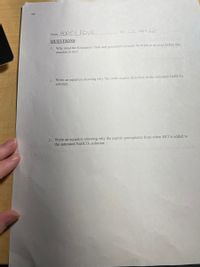
Chemistry
10th Edition
ISBN: 9781305957404
Author: Steven S. Zumdahl, Susan A. Zumdahl, Donald J. DeCoste
Publisher: Cengage Learning
expand_more
expand_more
format_list_bulleted
Question

Transcribed Image Text:426
Name Haley Doyle
Sec.O Exp. # 26
QUESTIONS
1. Why must the Erlenmyer flask and graduated cylinder be dried in an oven before the
reaction is run?
a. Write an equation showing why the crude aspirin dissolves in the saturated NaHCO3
solution.
b. Write an equation showing why the aspirin precipitates from when HCl is added to
the saturated NaHCO3 solution.
Expert Solution
This question has been solved!
Explore an expertly crafted, step-by-step solution for a thorough understanding of key concepts.
This is a popular solution
Trending nowThis is a popular solution!
Step by stepSolved in 2 steps with 1 images

Knowledge Booster
Learn more about
Need a deep-dive on the concept behind this application? Look no further. Learn more about this topic, chemistry and related others by exploring similar questions and additional content below.Similar questions
- 2. Do the following calculations:a) Calculate the experimental % hydrolysis for 1 M NaC2H3O2 and 1 M Na2CO3 .(experimental means you can only use your measurements- do not look up any K values)b) Calculate the theoretical % hydrolysis for 1 M NaC2H3O2 and 1 M Na2CO3(these are done using published K values)c) Calculate % error or % difference between experimental and theoretical % hydrolysis values. Data: Part 1 1M of: NaCH3CO2 ph=8.79 NaCl ph = 6.89 NH4Cl ph=5.06 NH4CH3CO2 ph = 6.90 Na2CO3 ph=11.82 Part 2 NH4Cl(s) - smell weak NH4CH3CO2 (s)- smell medium (NH4)2CO3(s)- smell strong Part 3 0.1 M NaH2PO4 ph=8.56 0.1 M Na2HPO4 ph=4.65 Part 4 2g of Al2(SO4) (s) + 10 ml H2O (50 ml beaker) ph = 7.96 2g NaHCO3(s) + 10 ml H2O (50 ml beaker) ph = 3.07arrow_forwardPlease don't provide handwrittin solution...arrow_forwardThis series demonstrates a progression as 0.5 M solution of sodium carbonate (?? ?? ) as it is added drop-by-drop to a test tube containing 0.2 M solution of lead (II) nitrate (??(?? ) ) 1. What observations indicate that a chemical reaction has occurred? 2. Break up the reactants into ions. Switch the cations. Use the “criss-cross” method to get the balanced formulas for the products. Write the balanced molecular equation for this reaction, including phase labels. 3. Write the complete ionic equation for this reaction. 4. Write the net ionic equation for this reaction. 5. What is the precipitate?arrow_forward
- Also tell which pricipitate is formed and next logical caution to remove ?arrow_forward3. Write an equation showing the dissolution reaction for each of the precipitates that was soluble in CH3COOH solution.arrow_forwardHow would the solid AgOH (came from KOH) solubility be affected when hydrochloric acid is added?arrow_forward
- Can you please answer the question? Thank youarrow_forwardAddition of manganses chloride to a saturated solution of silver (I) chloride causes a/an _______ in mass of precipitate due to _________ a. increase, shifting towards formation of products b. decrease, shifting towards formation of products c. increase, shifting towards formation of reactants d. decrease, shifting towards formation of reactantsarrow_forwardHow would the average calculated concentration of NaOH have been affected (Higher, Lower, No Change) if... 1. undissolved KHP was present in the bottom of the flask at the "end" of the titration. 2. you stopped the titration (and recorded the volume of NaOH added) immediately after the solution first became pink, however, the pink color disappeared almost immediately.arrow_forward
- In the reaction between magnesium cyanide and sodium hydroxide to yield sodium cyanide and magnesium hydroxide, the coefficient in front of the magnesium hydroxide is __________. 1 2 3 4 5arrow_forwardA – if both statements are correct.B – if the first statement is correct and the second is wrong C – if the first statement is wrong and the second is correct.D – if both statements are wrong.arrow_forward1. Give possible reasons why the percentage recovery might be low. a. b. c. 2. Give possible reasons why the percentage recovery might be over 100%. a. b. c. 3. How many milliliters of 3.0 M NaOH are required to react with 4.0 mL of 16.0 M HNO3? Equation: Answer__________________arrow_forward
arrow_back_ios
SEE MORE QUESTIONS
arrow_forward_ios
Recommended textbooks for you
 ChemistryChemistryISBN:9781305957404Author:Steven S. Zumdahl, Susan A. Zumdahl, Donald J. DeCostePublisher:Cengage Learning
ChemistryChemistryISBN:9781305957404Author:Steven S. Zumdahl, Susan A. Zumdahl, Donald J. DeCostePublisher:Cengage Learning ChemistryChemistryISBN:9781259911156Author:Raymond Chang Dr., Jason Overby ProfessorPublisher:McGraw-Hill Education
ChemistryChemistryISBN:9781259911156Author:Raymond Chang Dr., Jason Overby ProfessorPublisher:McGraw-Hill Education Principles of Instrumental AnalysisChemistryISBN:9781305577213Author:Douglas A. Skoog, F. James Holler, Stanley R. CrouchPublisher:Cengage Learning
Principles of Instrumental AnalysisChemistryISBN:9781305577213Author:Douglas A. Skoog, F. James Holler, Stanley R. CrouchPublisher:Cengage Learning Organic ChemistryChemistryISBN:9780078021558Author:Janice Gorzynski Smith Dr.Publisher:McGraw-Hill Education
Organic ChemistryChemistryISBN:9780078021558Author:Janice Gorzynski Smith Dr.Publisher:McGraw-Hill Education Chemistry: Principles and ReactionsChemistryISBN:9781305079373Author:William L. Masterton, Cecile N. HurleyPublisher:Cengage Learning
Chemistry: Principles and ReactionsChemistryISBN:9781305079373Author:William L. Masterton, Cecile N. HurleyPublisher:Cengage Learning Elementary Principles of Chemical Processes, Bind...ChemistryISBN:9781118431221Author:Richard M. Felder, Ronald W. Rousseau, Lisa G. BullardPublisher:WILEY
Elementary Principles of Chemical Processes, Bind...ChemistryISBN:9781118431221Author:Richard M. Felder, Ronald W. Rousseau, Lisa G. BullardPublisher:WILEY

Chemistry
Chemistry
ISBN:9781305957404
Author:Steven S. Zumdahl, Susan A. Zumdahl, Donald J. DeCoste
Publisher:Cengage Learning

Chemistry
Chemistry
ISBN:9781259911156
Author:Raymond Chang Dr., Jason Overby Professor
Publisher:McGraw-Hill Education

Principles of Instrumental Analysis
Chemistry
ISBN:9781305577213
Author:Douglas A. Skoog, F. James Holler, Stanley R. Crouch
Publisher:Cengage Learning

Organic Chemistry
Chemistry
ISBN:9780078021558
Author:Janice Gorzynski Smith Dr.
Publisher:McGraw-Hill Education

Chemistry: Principles and Reactions
Chemistry
ISBN:9781305079373
Author:William L. Masterton, Cecile N. Hurley
Publisher:Cengage Learning

Elementary Principles of Chemical Processes, Bind...
Chemistry
ISBN:9781118431221
Author:Richard M. Felder, Ronald W. Rousseau, Lisa G. Bullard
Publisher:WILEY